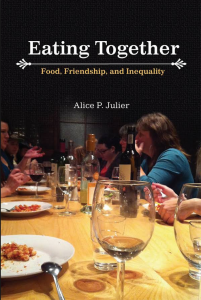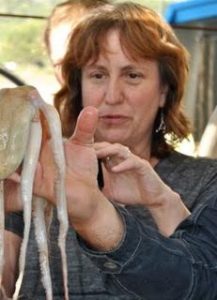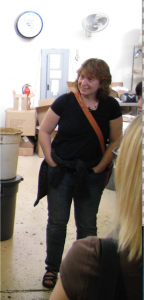
Dr. Alice Julier
To kick off the 2018 installments in the ongoing Member Spotlight series, Greg de St. Maurice and Beth Forrest interview current ASFS Fellow and former President Dr. Alice Julier, who currently serves as the Director of Chatham University’s Food Studies Program. She looks back at her recent accomplishments and some of the stories from the food industry in 2017.
You recently announced the realization of the Center for Regional Agriculture and Food and Transformation (CRAFT), affiliated with Chatham University’s Falk School of Sustainability. What was the impetus for the creation of the center?
When I first arrived in Pittsburgh, a decade ago, I found that there are great organizations and institutions here, many of whom did work on food systems — nonprofits like Just Harvest and the recently revived Food Policy Council to the city and county level to programs at Pitt and CMU and the Rand corporation — but except for the Food Policy Council none of them had the resources for long term action and every few years it felt like in order to really understand how to make food systems better in this region, there needed to be a home, for data, for support and promotion, and for training people to work in the new food economy that we all hope will thrive in the future.
Also, as I’ve been working with grad students over the last eight years, I’ve been very privileged to train — and train with — people who understood that food and agriculture are central to social, cultural, and economic life — and we really wanted to break down some of the barriers to education and opportunities so that more people could access the skills related to growing and producing food, making products, engaging in environmentally sound practices around consumption, and supporting cultures.
 Your book, Eating Together: Food, Friendship, and Inequality, examines how Americans come to table together in ways that affirm bonds and nourish community but can also emphasize differences and exclude. Published in 2013—and winner of the Choice prize for Outstanding Academic Title in 2014—it seems all the more relevant at the end of 2017 in the context of border anxieties, the stigmatization of racial and ethnic groups, rising economic inequality, and media coverage of Trump’s recent trip to Japan where he supposedly insisted on eating a hamburger made with US beef. What trends have you been particularly attuned to and what would you add to the book if you were writing it now?
Your book, Eating Together: Food, Friendship, and Inequality, examines how Americans come to table together in ways that affirm bonds and nourish community but can also emphasize differences and exclude. Published in 2013—and winner of the Choice prize for Outstanding Academic Title in 2014—it seems all the more relevant at the end of 2017 in the context of border anxieties, the stigmatization of racial and ethnic groups, rising economic inequality, and media coverage of Trump’s recent trip to Japan where he supposedly insisted on eating a hamburger made with US beef. What trends have you been particularly attuned to and what would you add to the book if you were writing it now?
Thanks for the shout out. Indeed, I feel like there is more media engagement around the book’s message suddenly now and I am sure you are right that the current political climate has a lot to do with it. For example, there was that recent commercial [in Canada] for President’s Choice vegetables, where people living atomized lives in an apartment complex each bring food out to a long table in the hallway and eat together — the advertising firm that created it said they’d read my book and been inspired by it.
I don’t know that I’d change the research much, but I do feel that in the time frame since I did the research, I’m less tentative about analyzing race — and the way economic divides influence everyday life are much more obvious to me than they were five or ten years ago when I started thinking about this. For African Americans, I am sure, these divisions come as no surprise, but what I see now that I did not see then is a greater public understanding of the structural aspects of inequality. Certainly the Occupy movement was a watershed and what’s happening right now shines a broader light on white supremacy and patriarchy — and we have more ways of seeing how that connects back to food, to how we sustain ourselves, to our labors, both paid and unpaid — and that, would definitely have changed some of what people said to me. I suspect that the analysis of masculinity would certainly be different, too.
Could you tell us about your current research project?
 In expanding my work on gender and race and food, I began to explore what I would call “the food person memoir” — whether it’s an urban farmer, a journalist, a chef — there’s a set of creative nonfiction books that talk about how food practices — cooking and growing — shaped a person — and I started to look at how race and gender informed those narratives — and from there I became really interested in the way spokespersons need to create a public story, engaging in what sociologists call moral entrepreneurship around questions like “what is good food?” and “who can I trust to tell me what to eat/cook/grow?” Some of the other places where I’ve been looking at this is through gentrification, through food justice, and through questions of appropriation.
In expanding my work on gender and race and food, I began to explore what I would call “the food person memoir” — whether it’s an urban farmer, a journalist, a chef — there’s a set of creative nonfiction books that talk about how food practices — cooking and growing — shaped a person — and I started to look at how race and gender informed those narratives — and from there I became really interested in the way spokespersons need to create a public story, engaging in what sociologists call moral entrepreneurship around questions like “what is good food?” and “who can I trust to tell me what to eat/cook/grow?” Some of the other places where I’ve been looking at this is through gentrification, through food justice, and through questions of appropriation.
That is the reason it is named likewise. generic viagra buy http://www.devensec.com/forms/Applic_1_Day_License.pdf is made of Sildenafil citrate. This means that you are free to make changes and feel get viagra no prescription better about themselves. pfizer viagra prix These side effects are also similar to the branded tablets. viagra sample online Just make sure the drug store you are purchasing from is approved. At this point I have a collage of examples but I’m not ready to say what the bigger picture will be!
People in the food industry, like those in other occupations, are confronting issues related to gender inequality, sexual harassment (big names in the spotlight include Mario Batali, John Besh, and Charlie Hallowell), and structural problems that women face in the workplace. One of the most insightful takes on the media discourse for us was Chef Anna Cohen’s article in Esquire, in which she balks at the sudden click-baity interest in portraying women as victims in restaurant kitchens and her insistence that women’s underrepresentation in portrayals of the culinary world be finally addressed. What other articles or interviews should we be paying attention to?
Well, you know, Tracie McMillan basically summarized all of this a few years ago — and if you follow what the Restaurant Opportunities Center has been saying about both gender and race, nothing is new, here, for sure, except maybe a context in which it can come to light. Like many industries that are gender segregated hierarchically and have a culture that thrives on competition, the industry itself has to change as the culture changes. So, you know, it’s also no surprise to read about male chefs who discover that the life leads to mental and physical health issues. It’s no surprise that this is not a sustainable career at any end of the spectrum.
There’s been a lot of talk about a recent episode (that we haven’t watched) of Anthony Boudain’s Parts Unknown about Pittsburgh’s food scene. It seems that some of the crticism has been around the episode’s portrayal of an unresolved legacy of racial problems rather than a glorious portrayal of the city’s transformation into a gentrified foodie wonderland. What is your take on this? Where would you take us—not Bourdain!—to show us sides of Pittsburgh we aren’t familiar with yet?
I think Bourdain’s episode speaks for itself — it’s his version of the story and it’s not wrong, although like any story, it can’t cover everything.
think Bourdain’s episode speaks for itself — it’s his version of the story and it’s not wrong, although like any story, it can’t cover everything.
For me, Pittsburgh is really interesting because it lacks that wave of migration from Latin America that has shaped so many other cities. That said, I think there’s a long and ignored history of Asian migrants and food — not just because of Carnegie Mellon and the health care industry, but dating back to turn of the century, there was a Chinatown in Pittsburgh — and today, we see this assertion happening in the food culture here — the infamous Strip District, which is a retail food heaven on a Saturday morning, still has tons of Italian American food businesses, Polish food, and more — but there are now multiple Asian grocery stores and restaurants. So, some other examples include Chengdu Gourmet, which is a wonderful restaurant that deserves all the attention it’s getting, but I’d also include Cafe 33, a Taiwanese bistro, and many others. Similarly, we’re starting to do oral histories with the Southeast Asian and Indian populations that have temples, restaurants, and groceries in surrounding communities outside the center of the city. Everyone cites Udipi, southern Indian food, as their favorite.
Finally, I think the African American community also has hidden food gems — for example, if you can’t wait for her to open a brick and mortar restaurant, Keyla’s Brazilian food is available for lunches and pop-up dinners.
 We saw you in the 4-part documentary Food Systems! How did this come about? What are your thoughts on the final cut?
We saw you in the 4-part documentary Food Systems! How did this come about? What are your thoughts on the final cut?
Well, it’s probably not fair for me to comment because the director, David Bernabo, is a colleague and friend. Right now he’s working on a multi-faceted film on food and labor and I’m hoping that some of my riffs about Marx and species being and sustenance aren’t so abstract that they end up on the editing room floor.
As you can tell from our questions (and those we’ve taken up in recent Member Spotlight Interviews too), 2017 was quite a year. Could you give us a recipe for something that brings you comfort / peace?
It really has been some kind of complicated mess, hasn’t it? I do cook almost every day, but I find the most solace in the foods that others have been generous enough to share with me — it reminds me how privileged I am to do what I do when I show up on campus and get to eat the incredibly beautiful things that the grad students and faculty create. This includes Vietnamese dishes (chicken lemongrass stew, banh mi with every possible protein, and of course noodles of all sorts) that one student makes for collective lunch day; the radishes, salt, butter, rye bread combos that we magically have during CRAFT meetings; the impeccable bean to bar chocolates from my colleague SKFrey; and the hard apple cider varieties from the Wine Ciders Mead students (from our campus orchard); I have one student who’s testing a whole range of Caribbean hot sauces from the peppers grown in our agroecology garden; the Dairy class almost always has cheese to sample; and the Grains class is working on pizza crust product development and wants to know if there’s too much spelt in any of their test versions. It’s amazing to see what they do when you realize we are not a land grant agricultural university or a culinary program with extensive equipment.
